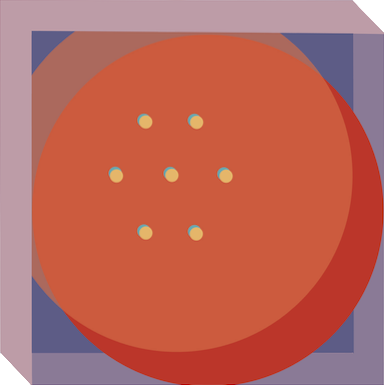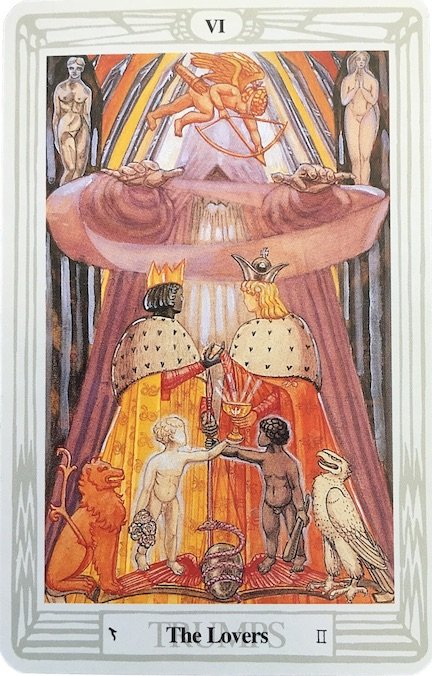THE LOVERS : KEY VI
The Children of the Voice:
the Oracle of the Mighty Gods
Zodiacal Trump of Gemini
Mercury Rules
Dragon’s Head Exalted
Hebrew letter: Zain (Sword)
Path 17 joining
Sphere 3-Understanding and 6-Beauty
The Oracle of the Gods is the Child-Voice of Love in Thine own Soul! hear thou it!
Heed not the Siren-Voice of Sense, or the Phantom-Voice of Reason: rest in Simplicity, and listen to the Silence.
Openness to inspiration, intuition, intelligence, second sight, childishness, frivolity, thoughtfulness divorced from practical consideration, indecision, self-contradiction, union in a shallow degree with others, instability, contradiction, triviality, the “high-brow”
Alesiter Crowley
The Book of Thoth
This card and its twin, XIV, Art, are the most obscure and difficult of the Atu. Each of these symbols is in itself double, so that the meanings form a divergent series, and the integration of the Card can only be regained by repeated marriages, identifications, and some form of Hermaphroditism.
Yet the attribution is the essence of simplicity. Atu VI refers to Gemini, ruled by Mercury. It means The Twins. The Hebrew letter corresponding is Zain, which means a Sword, and the framework of the card is therefore the Arch of Swords, beneath which the Royal Marriage takes place.
To each his Understanding sooth discovers Wordless: your mode, immortal Twins and Lovers!
The Sword is primarily an engine of division. In the intellectual world-which is the world of the Sword suit-it represents analysis. This card and Atu XIV together compose the comprehensive alchemical maxim: Solve et coagula.
This card is consequently one of the most fundamental cards in the Tarot. It is the first card in which more than one figure appears. [The Ape of Thoth in Atu I is only a shadow.] In its original form, it was the story of Creation.
Here is appended, for its historical interest, the description of this card in its primitive form from Liber 418.
“There is an Assyrian legend of a woman with a fish, and also there is a legend of Eve and the Serpent, for Cain was the child of Eve and the Serpent, and not of Eve and Adam; and therefore when he had slain his brother, who was the first merderer, having sacrificed living things to his demon, had Cain the mark upon his brow, which is the mark of the Beast spoken of in the Apocalypse, and is the sign of Initiation.
“The shedding of blood is necessary, for God did not hear the children of Eve until blood was shed. And that is external religion; but Cain spake not with God, nor had the mark of initiation upon his brow, so that he was shunned of all men, until he had shed blood. And this blood was the blood of his brother. This is a mystery of the sixth key of the Tarot, which ought not be The Lovers, but The Brothers.
“In the middle of the card stands Cain; in his right hand is the Hammer of Thor with which he has slain his brother, and it is all wet with his blood. And his left hand he holders open as a sign of innocence. On his right hand is his mother Eve, around whom the serpent is entwined with his hood spread behind her head; and on his left hand is a figure somewhat like the Hindoo Kali, but much more seductive. Yet I know it to be Lilith. And above him the Great Sigil of the Arrow, downward, but it is struck through the heart of the child. This child is Abel. And the meaning of this part of the card is obscure, but that is the correct drawing of the Tarot card; and that is the correct magical fable from which the Hebrew scribes, who were not complete Initiates, stole their legend of the Fall and the subsequent events.”
It is very significant that almost every sentence in this passage seems to reverse the meaning of the previous one. This is because reaction is always equal and opposite to action. This equation is, or should be, simultaneous in the intellectual world, where there is no great time lag; the formulation of any idea creates its contradictory at almost the same moment. The contradictory of any proposition is implicit in itself. This is necessary to preserve the equilibrium of the Universe. The theory has been explained in the essay on Atu I, the Juggler, but must now be again emphasized in order to interpret this card.
The key is that the card represents the creation of the World. The Hierarchs held this secret as of transcendent importance. Consequently, the Initiates who issued the Tarot, for use during the Aeon of Osiris, superseded the original card above described in “The Vision and the Voice”. They were concerned to create a new Universe of their own; they were the fathers of Science. Their methods of working, grouped under the generic term Alchemy, have never been made public. The interesting point is that all developments of modern science in the last fifty years have given intelligent and instructed people the opportunity of reflecting that the whole trend of science has been to return to alchemical aims and (mutatis mutandis) methods. The secrecy observed by the alchemists was made necessary by the power of persecuting Churches. Bitterly as bigots fought among themselves, they were all equally concerned to destroy the infant Science, which, as they instinctively recognized, would put an end to the ignorance and faith on which their power and wealth depended.
The subject of this card is Analysis, followed by Synthesis. The first question asked by science is: “How shall we recombine them to our greater advantage?” This resumes the whole policy of the Tarot.
The hooded figure which occupies the centre of the Card is another form of The Hermit, who is further explained in Atu IX. He is himself a form of the god Mercury, described in Atu I; he is closely shrouded, as if to signify that the ultimate reason of things lies in a realm beyond manifestation and intellect. (As elsewhere explained, only two operations are ultimately possible —- analysis and synthesis).
He is standing in the Sign of the Enterer, as if projecting the mysterious forces of creation. About his arms is a scroll, indicative of the Word which is alike his essence and his message. But the Sign of the Enterer is also the Sign of Benediction and of Consecration; thus his action in this card is the Celebration of the Hermetic Marriage. Behind him are the figures of Eve, Lilith and Cupid. This symbolism has been incorporated in order to preserve in some measure the original form of the card, and to show its derivation, its heirship, is continuity with the past. On the quiver of Cupid is inscribed the word Thelema, which is the Word of the Law. (See Liber AL, chap. I, verse 39.) His shafts are quanta of Will. It is thus shown that this fundamental formula of magical working, analysis and synthesis, persists through the Aeons.
One may now consider the Hermetic Marriage itself. This part of the Card has been simplified from “the Chemical Marriage of Christian Rosenkreutz”, a masterpiece too lengthy and diffuse to quote usefully in this place. But the essence of the analysis is the continuous see-saw of contradictory ideas. It is a glyph of duality. The Royal persons concerned are the Black or Moorish King with a golden crown, and the White Queen with a silver crown. He is accompanied by the Red Lion, and she by the White Eagle. These are symbols of the male and female principles in Nature; they are therefore equally, in various stages of manifestation, Sun and Moon, Fire and Water, Air and Earth. In chemistry they appear as acid and alkali, or (more deeply) metals and non-metals, taking those words in their wildest philosophical sense to include hydrogen on the one hand and oxygen on the other. In this aspect, the hooded figure represents the Protean element of carbon, the seed of all organic life.
The symbolism of male and female is carried on still further by the weapons of the Kind and Queen; he bears the Sacred Lance, and she the Holy Grail; their other hands are joined as consenting to the Marriage. Their weapons are supported by twin children, whose positions are counterchanged; for the white child not only holds the Cup, but carries roses, while the black child, holding his father’s Lance, carries also the club, and equivalent symbol. At the bottom of the whole is the result of the marriage in primitive and pantomorphic form; it is the winged Orphic egg. This egg represents the essence of all that life which comes under this formula of male and female. It carries on the symbolism of the Serpents with which the King’s robe is embroidered, and of the Bees which adorn the mantle of the Queen. The egg is grey, mingling white and black; thus it signifies the co-operation of the three Supernals of the Tree of Life. The color of the Serpent is purple, Mercury in the scale of the Queen. It is the influence of that God manifested in Nature, whereas the wings are tinged with crimson, the color (in the King scale) of Binah the great Mother. In this symbol is therefore a complete glyph of the equilibrium necessary to begin the Great Work. But, as to the final mystery, that is left unsolved. Perfect is the plan to produce life, but the nature of this life is concealed. It is capable of taking any possible form; but what form? That is dependent upon the influences attendant on gestation.
The figure in the air presents some difficulty. The traditional interpretation of the figure is that he is Cupid; and it is not at first clear what Cupid has to do with Gemini. No light is thrown upon this point by consideration of the position of the path upon the Tree of LIfe, for Gemini leads from Binah to Tiphareth. There accordingly arises the whole question of Cupid. Roman gods usually represent a more material aspect of the Free gods from whom they are derived; in this case, Eros. Eros is the son of Aphrodite, and tradition varies as to whether his father was Ares, Zeus or Hermes—that is Mars, Jupiter or Mercury. His appearance in this card suggests that Hermes is the true sire; and this view is confirmed by the fact that it is not altogether easy to distinguish him from the child Mercury, for they have in common wantonness) irresponsibility, and the love of playing tricks. But in this image are peculiar characteristics. He carries a bow and arrows in a golden quiver. (He is sometimes represented with a torch.) He has golden wings, and is blindfolded. From sometimes represented with a torch.) He has golden wings, and is blindfolded. From this, it may appear that he represents the intelligent (and, at the same time, unconscious) will of the soul to unite itself with all and sundry, as has been explained in the general formula with regard to the agony of separateness.
No very special importance is attached to Cupid in alchemical figures. Yet, in one sense, he is the source of all action; the libido to express Zero as Two. From another point of view, he may be regarded as the intellectual aspect of the influence of Binah upon Tiphareth, for (in one tradition) the title of the card is “The Children of the Voice, the Oracle of the Mighty Gods”. From this point of view, he is a symbol of inspiration, descending upon the hooded figure, who is, in this instance, a prophet operating the conjunction of the King and Queen. His arrow represents the spiritual intelligence necessary in alchemical operation, rather than the mere hunger to perform them. On the other hand, the arrow is peculiarly a symbol of direction, and it is, therefore, proper to put the word “Thelema” in Greek letters on the quiver. It is also to be observed that the opposite card, Sagittarius, means the Bearer of the Arrow, or Archer, a figure who does not appear in any form in Atu XIV. These two cards are so complementary that they cannot be studied separately, for full interpretation.

Joan Bunning
The Lovers is one card that is easy to remember. Love and sex are riveting subjects, and, as you’d expect, this card represents both. The urge for union is powerful, and, in its highest form, takes us beyond ourselves. That is why an angel is blessing the bond between the man and woman on this card.
In readings, Card 6 often refers to a relationship that is based on deep love – the strongest force of all. The relationship may not be sexual, although it often is or could be. More generally, the Lovers can represent the attractive force that draws any two entities together in a relationship – whether people, ideas, events, movements or groups.
Card 6 can also stand for tough value choices and the questioning that goes with them. In some decks, the Lovers shows a man torn between two women – a virgin and a temptress. This rather old-fashioned triangle symbolizes the larger dilemmas we face when we are tempted between right and wrong.
The Lovers can indicate a moral or ethical crossroads – a decision point where you must choose between the high road or the low road. This card can also represent your personal beliefs because to make such a decision you must know where you stand. Following your own path can mean going against those who are urging you in a direction that is wrong for you.
THE LOVERS’ ACTIONS
RELATING TO OTHERS
feeling love
forming a union or marriage
acknowledging kinship
sympathizing with another
getting closer
making a connection
being intimate
BEING SEXUAL
experiencing desire
making love
opening to another
responding with passion
feeling a physical attraction
tapping inner energy
ESTABLISHING PERSONAL BELIEFS
figuring out where you stand
staying true to yourself
setting your own philosophy
going by your own standards
making up your own mind
DETERMINING VALUES
struggling with temptation
choosing between right and wrong
facing an ethical or moral choice
refusing to let ends justify means
finding out what you care about
THE LOVERS’ ROLE IN THE FOOLS JOURNEY
Eventually, the Fool faces two new challenges. He experiences the powerful urge for sexual union with another person. Before, he was mainly self-centered. Now he feels the balancing tendency, pictured in the Lovers (6), to reach out and become half of a loving partnership. He yearns for relationship.
The Fool also needs to decide upon his own beliefs. It is well enough to conform while he learns and grows, but at some point, he must determine his own values if he is to be true to himself. He must start to question received opinion.
A.E. Waite
The Pictorial Key to the Tarot
The sun shines in the zenith, and beneath is a great winged figure with arms extended, pouring down influences. In the foreground are two human figures, male and female, unveiled before each other, as if Adam and Eve when they first occupied the paradise of the earthly body. Behind the man is the Tree of Life, bearing twelve fruits, and the Tree of the Knowledge of Good and Evil is behind the woman; the serpent is twining round it. The figures suggest youth, virginity, innocence and love before it is contaminated by gross material desire. This is in all simplicity the card of human love, here exhibited as part of the way, the truth and the life. It replaces, by recourse to first principles, the old card of marriage, which I have described previously, and the later follies which depicted man between vice and virtue. In a very high sense, the card is a mystery of the Covenant and Sabbath.
The suggestion in respect of the woman is that she signifies that attraction towards the sensitive life which carries within it the idea of the Fall of Man, but she is rather the working of a Secret Law of Providence than a willing and conscious temptress. It is through her imputed lapse that man shall arise ultimately, and only by her can he complete himself. The card is therefore in its way another intimation concerning the great mystery of womanhood. The old meanings fall to pieces of necessity with the old pictures, but even as interpretations of the latter, some of them were of the order of commonplace and others were false in symbolism.


